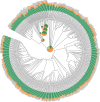eggNOG: automated construction and annotation of orthologous groups of genes
- PMID: 17942413
- PMCID: PMC2238944
- DOI: 10.1093/nar/gkm796
eggNOG: automated construction and annotation of orthologous groups of genes
Abstract
The identification of orthologous genes forms the basis for most comparative genomics studies. Existing approaches either lack functional annotation of the identified orthologous groups, hampering the interpretation of subsequent results, or are manually annotated and thus lag behind the rapid sequencing of new genomes. Here we present the eggNOG database ('evolutionary genealogy of genes: Non-supervised Orthologous Groups'), which contains orthologous groups constructed from Smith-Waterman alignments through identification of reciprocal best matches and triangular linkage clustering. Applying this procedure to 312 bacterial, 26 archaeal and 35 eukaryotic genomes yielded 43 582 course-grained orthologous groups of which 9724 are extended versions of those from the original COG/KOG database. We also constructed more fine-grained groups for selected subsets of organisms, such as the 19 914 mammalian orthologous groups. We automatically annotated our non-supervised orthologous groups with functional descriptions, which were derived by identifying common denominators for the genes based on their individual textual descriptions, annotated functional categories, and predicted protein domains. The orthologous groups in eggNOG contain 1 241 751 genes and provide at least a broad functional description for 77% of them. Users can query the resource for individual genes via a web interface or download the complete set of orthologous groups at http://eggnog.embl.de.
Figures


References
-
- Fitch WM. Distinguishing homologous from analogous proteins. J. Biol. Chem. 1970;19:99–113. - PubMed
-
- Tatusov RL, Koonin EV, Lipman DJ. A genomic perspective on protein families. Science. 1997;278:631–637. - PubMed
-
- Sonnhammer EL, Koonin EV. Orthology, paralogy and proposed classification for paralog subtypes. Trends Genet. 2002;18:619–620. - PubMed
-
- Koonin EV. Orthologs, paralogs, and evolutionary genomics. Annu. Rev. Genet. 39:309–338. - PubMed
MeSH terms
Substances
LinkOut - more resources
Full Text Sources
Other Literature Sources
Medical

